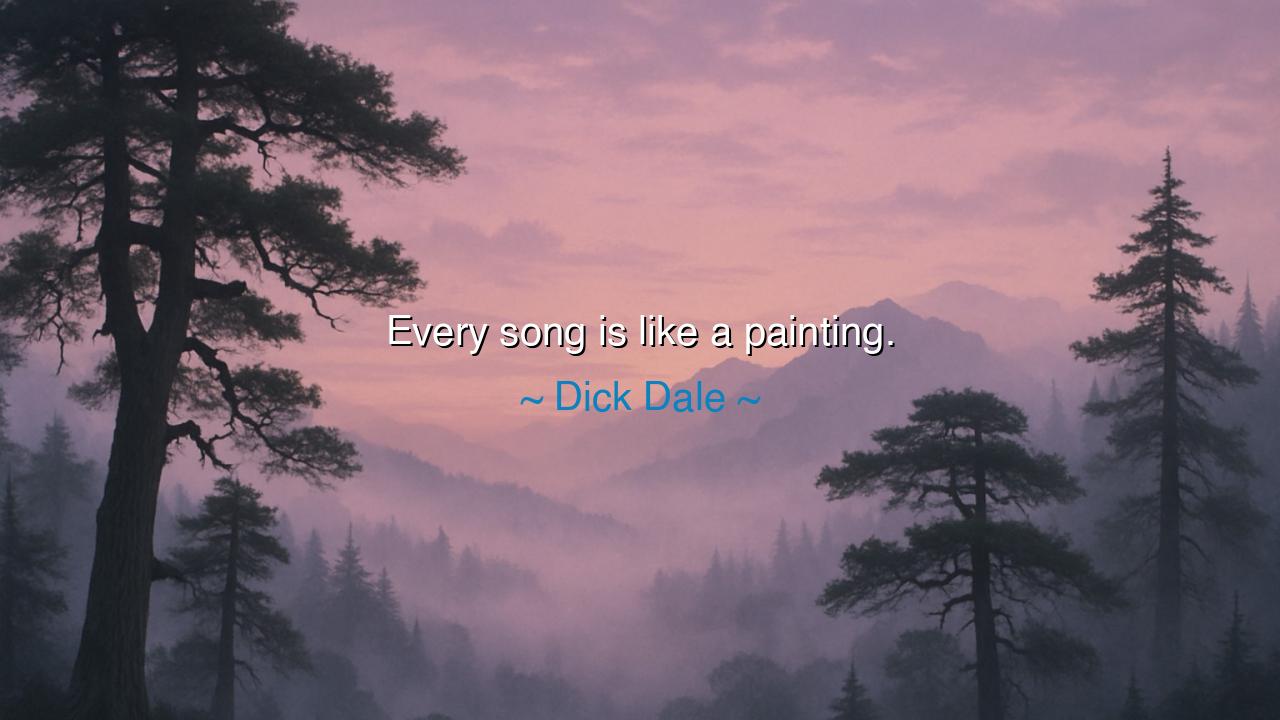
Every song is like a painting.






Dick Dale, the “King of the Surf Guitar,” once declared: “Every song is like a painting.” In this simple but luminous statement, he drew a bridge between the world of sound and the world of sight, showing that art, whether made of colors or of tones, springs from the same eternal source—the human soul. A song is not merely a sequence of notes, nor is a painting merely strokes of pigment; both are visions made visible, emotions made tangible, revelations made eternal.
To call a song a painting is to say that it is more than entertainment—it is an image of the spirit. Where the painter uses brush and color, the musician uses melody and rhythm. Each creates layers, shades, and textures; each tells a story without words, guiding the heart through landscapes of sorrow, joy, longing, or triumph. Dale, whose guitar roared like the ocean, understood this deeply: his music painted waves, salt air, sunlight, and thunder within the hearts of those who listened. His strings were his brushes, and the world his canvas.
History itself affirms this truth. Consider Beethoven, who painted storms and pastoral fields with his symphonies, turning the silent concert hall into a living landscape of emotion. When listeners heard his “Pastoral Symphony,” they did not need to be told of shepherds, streams, and storms—the music painted these images in their minds. In the same way, Claude Monet painted water lilies that seemed to sing in silence. Thus Dale’s words unite two worlds: the song paints what the eye cannot see, and the painting sings what the ear cannot hear.
There is also a heroic meaning in Dale’s metaphor. For he invites us to see that every song, like every painting, is unique. No two brushstrokes are alike, no two melodies identical in soul. Each work is a fragment of the artist’s being, a glimpse into the inner world. Dale himself battled illness and hardship, yet his music overflowed with power and vitality, as though he poured his very life onto the canvas of his guitar. Each performance was a painting of his soul—raw, vivid, and unrepeatable.
The ancients knew this truth as well. The Greeks spoke of the mousai, the Muses, who inspired all arts alike—poetry, song, dance, and visual creation. They did not separate music from painting, or rhythm from sculpture, but saw all as expressions of the divine spark. Dale, though of modern times, echoed this ancient wisdom: that all art, no matter its form, is born of the same sacred impulse to capture the fleeting and make it eternal.
The meaning of Dale’s words is therefore both poetic and practical. He reminds us that to create is to paint—whether with brushes, with strings, with words, or with deeds. Every song you hear is an image; every painting you see is a melody in disguise. To honor art is to recognize its power to translate the invisible into something we can hold, see, and feel.
For us who hear this teaching today, the lesson is clear: do not take music lightly, nor any form of art. When you listen to a song, ask yourself—what picture is it painting in my heart? When you gaze at a painting, listen—what melody whispers within it? Practical steps follow: listen deeply, not passively; create boldly, not timidly; and understand that whatever you craft, whether in art, work, or love, becomes a painting of your spirit. Make sure it is one worth beholding.
Thus Dick Dale’s words endure: “Every song is like a painting.” Let them remind you that every note is a brushstroke, every rhythm a color, every harmony a vision. When you hear music, you are gazing upon a living canvas of the soul. And when you create, know that you too are painting your spirit upon the world, leaving behind an image that will outlast you, as eternal as the sea that roared through Dale’s guitar.






AAdministratorAdministrator
Welcome, honored guests. Please leave a comment, we will respond soon